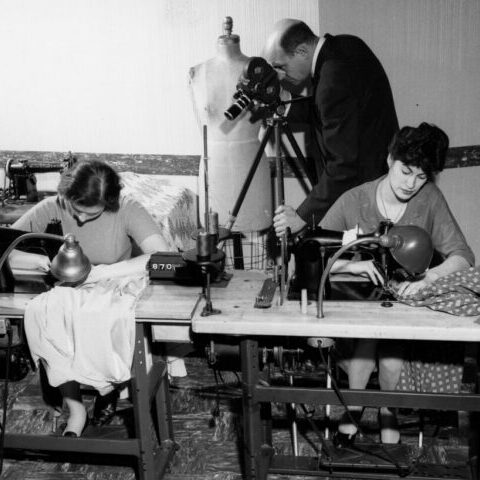Time and motion studies date back to the late nineteenth century with the work of Frederick Taylor (1856–1915). Taylor started the efficiency movement, advocating the scientific management and systematic observation for all manufacturing processes. He is known as the father of scientific management.[i]
Time and motion studies were introduced to evaluate each work task by Frank Gilbreth (1868–1924) and his wife Lillian Gilbreth (1878–1972). The Gilbreth’s were early efficiency experts who introduced process maps to conduct time and motion studies. Lillian is widely accepted as the mother of industrial engineering, also known as methods engineering.[ii] They became famous in popular culture with the book and movie about their lives, Cheaper by the Dozen.
While closely aligned there is a difference between a time study and a motion study. A time study is a direct and continuous observation of a task, using some kind of timekeeping device, such as a camera recording or stopwatch. Time studies are typically used to analyze repetitive tasks with the goal of improving efficiency, reducing fatigue, and preventing defects. A motion study determines all the movements made by workers in performing tasks.
The goal of motion studies is to reduce all types of waste.
The common goal of time and motion studies is to improve physical operations and processes measured by various time metrics. The most commonly used time metrics are lead times, cycle times, takt times, work times or value-added times. I learned to use each of these metrics over my 40 years in manufacturing and supply chain operations starting in purchasing, then in production planning and finally in Lean Six Sigma continuous improvement projects.
Lead Time. In purchasing lead time is the commitments from suppliers to deliver goods and services. It is also the commitment date made by manufacturers and distributors to their customers.
Cycle Time. In manufacturing cycle time is the total time it takes to complete the production of one unit from start to finish. Cycle time is a measure of the work it takes to compete a task regardless of the customer’s demand.
Takt Time. Takt is the German word for “pulse” and is the rate required to complete production orders to meet a customer’s demand. Just as a human heart rate and pulse can increase or decrease depending on physical activity, a company’s takt time can be low or high compared to customer demand. The goal is to eliminate over and under production as measured by takt time and to balance takt time and cycle time.
Work Time or Value-Added Time. In most continuous improvement projects I ran over several years we usually worked to eliminate or at least reduce the largest bottlenecks on the factory floor. We did this by comparing the total cycle time to complete a process versus the actual time working on tasks in a process. Work time is also known as value-added time which is a central pillar of Lean’s philosophy to eliminate wastes of all types. First introduced as part of the Toyota Production System, most time and motion studies found processes are inherently full of waste.
Problems with Traditional Time and Motion Studies
Traditional time and studies are created by conducting interviews, holding brainstorming meetings, and through personal observations, the classic image of an industrial engineer with a stopwatch and clip board. There are major limitations using these techniques because of process variations such as:
- Shifts. Swing and night shifts are often less effective due to a variety of issues including sleep deprivation, reduced supervision, and higher employee turnover.
- Individual Workers. There can be major differences based on experience.
- Days of the Week. Mondays and Fridays are known to be less effective.
- Seasons of the Year. Seasonality has been well documented.[iii]
- Hawthorne effect. This is referring to the type of reactivity in which individuals modify their behavior in response to their awareness of being observed. Time and motion studies suffer from the Hawthorne effect, which translates into improvements diminishing once the project ends and observers depart. It is human nature for folks to want to do better when they are being observed and being measured.
Time and Motion Studies Using Smart Technologies
Process variations and the Hawthorne Effect can be effectively addressed with today’s Smart Technologies such as the Industrial IoT devices and computer vision. Smart Technologies replace limited data collection with 24×7 monitoring off all areas of interest regardless of locations, shifts, and seasons of the year. Smart Technologies can also overcome the Hawthorne Effect because the observers never go away. They become ubiquitous and permanent in operations quickly flagging any backsliding away from standards.
The largest obstacle in improving time and motion studies may come in educating continuous improvement teams that their value to an organization will expand significantly with the new technologies while eliminating much of the labor-intensive work they are required to do.
Case study: 24×7 monitoring on Cycle Time
Here is the distribution of cycle time collected by PowerArena over a 24 hours period.
The cycle time of this workstation is 80 seconds.
For those cycles that take over 140 seconds: After reviewing the video footage, it is found that they are due to machine malfunctions or the workers need to wait for others to pass over the WIP and finish their tasks.
For those that take less than 40 seconds: It is due to workers who have skipped certain process steps.
There are several advantages of monitoring cycle time through Smart Technologies:
- Transparency: When managers do not have such data at their disposal, everything relies on word of mouth.
- Real-time: When the workers experience difficulties (like machine malfunctions), it used to take 30 mins – 60 mins to get to know the problems and resolve the issues. Now, the problem is notified in real time.
- Lean improvement: Video based Smart Technologies provide full traceability on the problems. By identifying the problems, finding out the root cause and coming up with a solution, that is how the manufacturing process can be improved.
Read More:
Smart Shop Floor Part 3: Supercharging Kaizen & Six Sigma With Computer Vision
Smart Shop Floor Part 4: 4M1E & Computer Vision-1Smart Shop Floor Part 1: What is Industry 4.0?
Anthony Tarantino, PhD
Six Sigma Master Black Belt, CPM (ISM), CPIM (APICS)
Adjunct Faculty Member, Santa Clara University
Author of Wiley’s Smart Manufacturing, The Lean Six Sigma Way. www.wiley.com (May 2022)
Senior Advisor to PowerArena
Notes
[i] Tarantino, Anthony, Smart Manufacturing, The Lean Six Sigma Way, (New York, John Wiley and Sons, 2022), Smart Manufacturing, the Lean Six Sigma Way | Wiley, Ch. 2.
[ii] Tarantino, Ch. 3.
[iii] Tarantino, Ch. 3.





